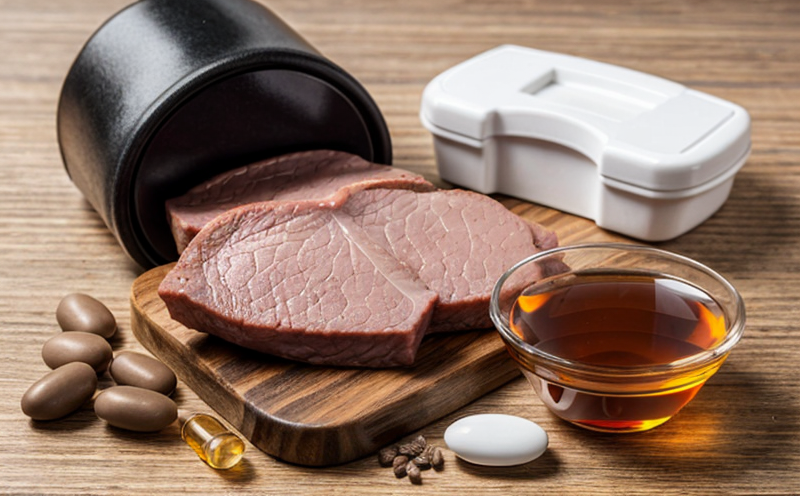Cytochrome P450 Induction Testing in Livestock Feed Safety Studies
The cytochrome P450 enzyme system is a crucial component of the hepatic detoxification pathway, playing a significant role in metabolizing xenobiotics and drugs. In livestock feed safety studies, understanding how feed components can potentially influence this pathway through cytochrome P450 induction or inhibition is essential for ensuring animal health and welfare.
Cytochrome P450 enzymes are primarily involved in Phase I metabolism, where they catalyze the hydroxylation of various substrates. This test evaluates whether a feed additive, ingredient, or contaminant can induce these enzymes to an abnormal level, which could lead to altered drug efficacy, increased toxicity, or reduced bioavailability.
The method typically employed for this assessment involves in vitro hepatic microsomal incubations using isolated liver samples from livestock. The test substrate often includes a specific probe compound recognized by the target P450 isoform (e.g., midazolam for CYP3A, tolbutamide for CYP2C9). By measuring the increase in enzymatic activity of this probe, we can determine the induction potential.
Induction can be a significant concern because it can lead to an overexpression of these enzymes, potentially reducing the effectiveness of therapeutic drugs administered alongside the feed. This is particularly critical for livestock, as suboptimal drug efficacy might impact treatment outcomes and animal health. The test results are compared against known reference values derived from standard protocols (e.g., ISO 17025).
Specimen preparation involves obtaining fresh hepatic tissue samples from the species of interest, typically from animals that have been fed a control diet for a specified period. These tissues are then processed to isolate microsomal fractions which contain the cytochrome P450 enzymes.
The test apparatus includes advanced spectrophotometric equipment designed for measuring enzymatic activity based on absorbance changes at specific wavelengths. The incubations are conducted under controlled conditions, ensuring consistency in temperature and pH, and the results are quantified by comparing the rate of substrate conversion to a set standard curve.
Given the complexity and importance of this test, it is crucial that the laboratory adheres strictly to international standards such as ISO 17025 for method validation and performance. This ensures the reliability and reproducibility of results, which are essential for regulatory compliance and trust in the industry.
The significance of this testing extends beyond simply identifying potential risks; it also provides valuable insights into the nutritional profile and safety of feed additives. By understanding how different components influence hepatic function, researchers can design safer and more effective feeds that support optimal animal health and performance.
Industry Applications
The results from cytochrome P450 induction testing are invaluable in various sectors within the livestock industry. Regulatory bodies use these data to establish safe limits for feed additives, ensuring that they do not adversely affect animal health or the effectiveness of therapeutic treatments.
R&D teams leverage this information to develop safer and more effective feeds by identifying components with high induction potential. This helps in formulating feeds that are better suited to meet specific nutritional requirements while minimizing risks associated with drug interactions.
Quality managers rely on the test outcomes to ensure compliance with stringent feed safety regulations, thereby protecting their reputation and consumer trust. They can use these data to make informed decisions regarding ingredient sourcing and formulation adjustments.
Why Choose This Test
The cytochrome P450 induction test is a critical tool for ensuring the safety of livestock feed additives. By identifying potential inducers early in the development process, industries can mitigate risks associated with adverse effects on animal health and welfare.
One major advantage of this testing methodology is its ability to provide quantitative data that can be used to refine formulations. This precision allows for more targeted and effective feed products, which can lead to improved productivity and health outcomes in livestock.
The test also offers a non-invasive alternative compared to some other safety assessments, making it an efficient choice for evaluating large-scale production batches without compromising on data quality.
Competitive Advantage and Market Impact
In the competitive landscape of livestock feed manufacturing, ensuring product safety is not only a regulatory requirement but also a key differentiator. By integrating cytochrome P450 induction testing into their quality control processes, companies can demonstrate their commitment to animal welfare and consumer confidence.
The ability to offer safer products can attract more discerning customers who prioritize ethical and sustainable practices. This not only enhances brand reputation but also opens up opportunities in emerging markets where there is a growing demand for high-quality livestock feed.
Moreover, the data generated from this testing can inform innovation strategies, leading to the development of safer and more effective feeds that meet the evolving needs of both producers and consumers. This forward-thinking approach positions companies at the forefront of industry trends, ensuring long-term sustainability and growth.





